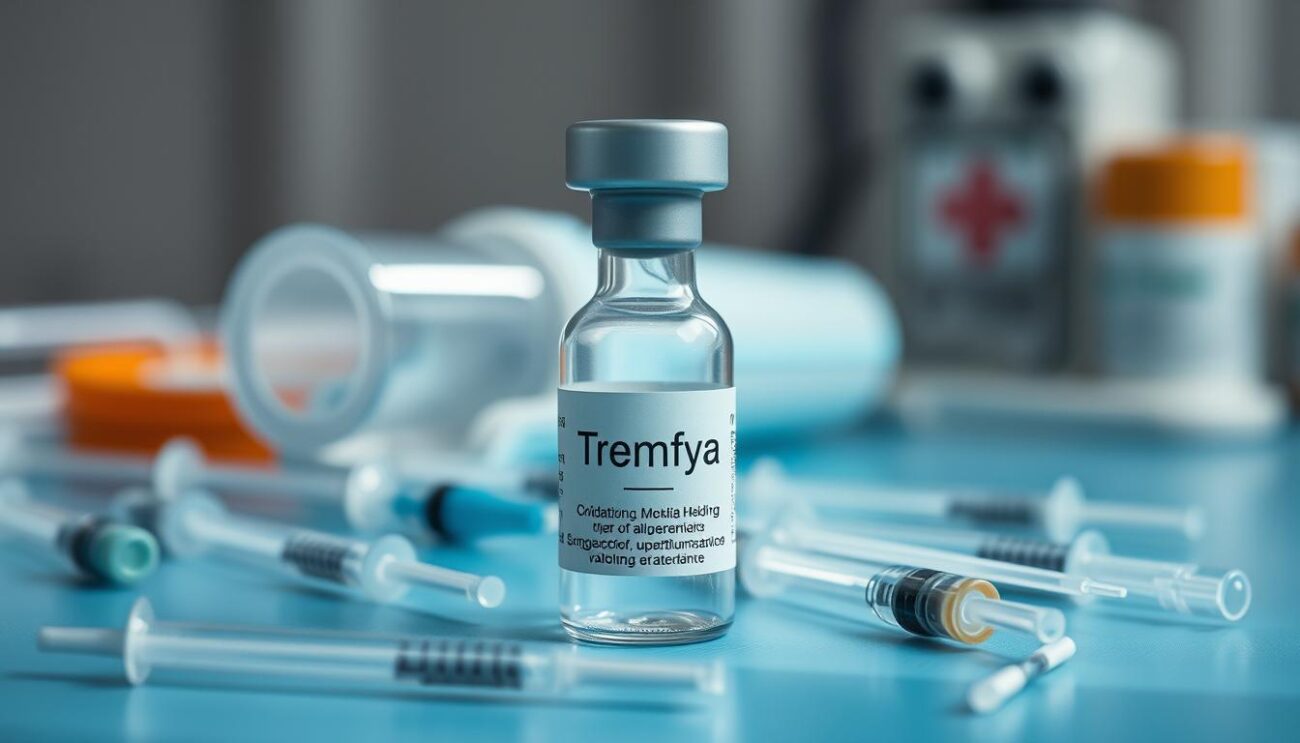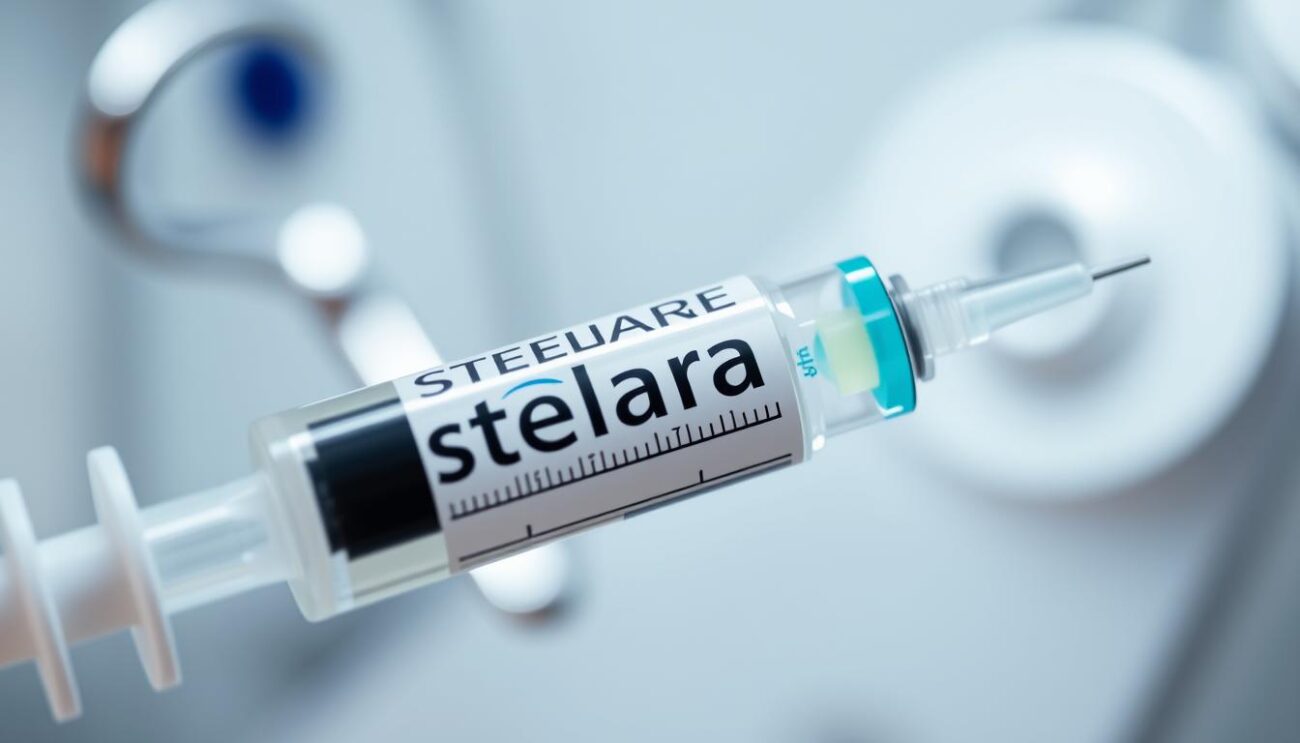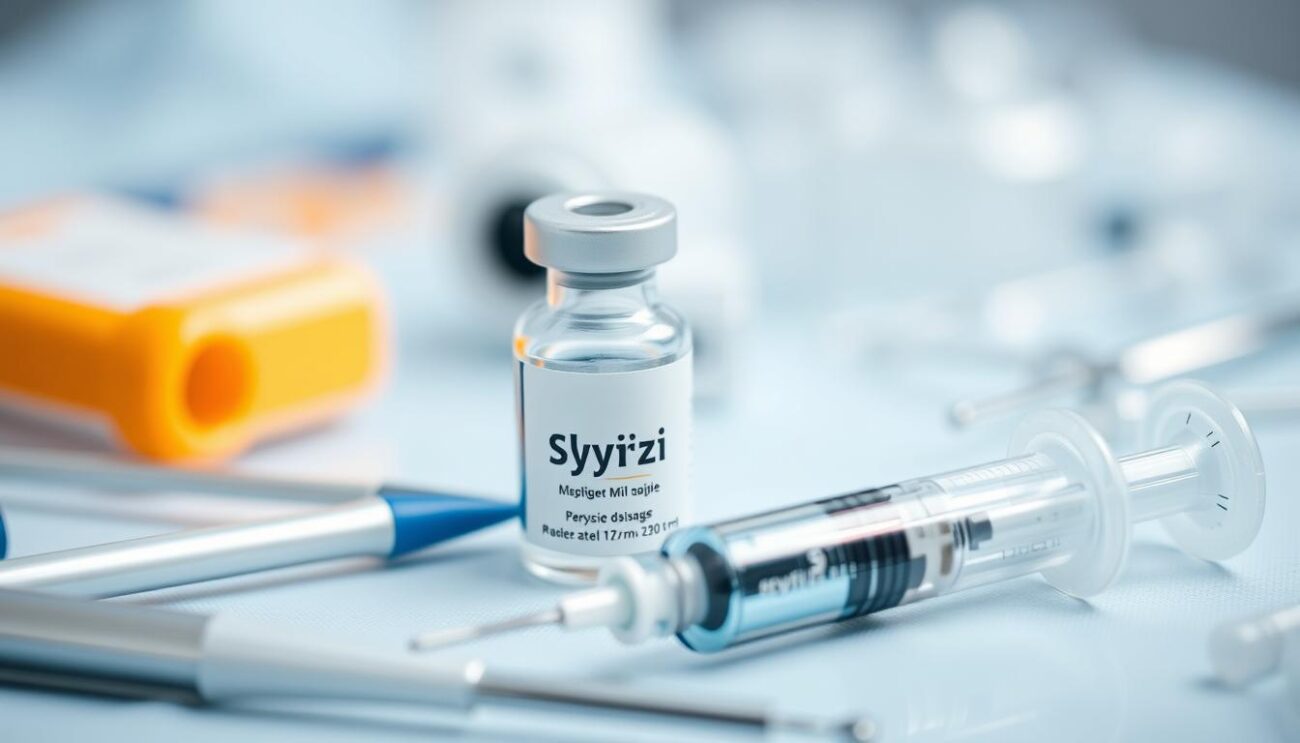Managing chronic conditions like plaque psoriasis and psoriatic arthritis requires a tailored approach. But what’s the right Taltz dose for you? Let’s explore how to find the best treatment plan for your needs.
Taltz (ixekizumab) is a medication approved by the FDA for various inflammatory conditions. It comes in single-dose syringes and autoinjectors, with a strong 80 mg/mL solution. However, the exact Taltz dose depends on your condition, age, and other factors.
Key Takeaways
- Taltz is a biologic medication approved to treat plaque psoriasis, psoriatic arthritis, ankylosing spondylitis, and nonradiographic axial spondyloarthritis.
- Dosing of Taltz involves a loading dose followed by maintenance doses, with the frequency and amount varying by condition and patient factors.
- Taltz can be self-administered or administered by a healthcare provider as a subcutaneous injection.
- Proper dosing and adherence to the treatment regimen are crucial for optimal outcomes with Taltz.
- Patients should work closely with their healthcare team to understand their Taltz dosage and administration schedule.
Introduction to Taltz Dosing
Taltz is a key medication for treating several inflammatory conditions. It helps manage chronic diseases like plaque psoriasis and psoriatic arthritis. Knowing how to dose Taltz is vital for patients to get the best results and control their condition well.
What is Taltz?
Taltz (ixekizumab) is a monoclonal antibody that targets interleukin-17A (IL-17A). IL-17A is a cytokine involved in inflammation. By blocking IL-17A, Taltz reduces inflammation and improves symptoms in autoimmune and inflammatory diseases.
Conditions Treated with Taltz
Taltz is approved for treating several conditions in adults:
- Moderate-to-severe plaque psoriasis
- Active psoriatic arthritis
- Active ankylosing spondylitis
- Active non-radiographic axial spondyloarthritis with signs of inflammation
Taltz has been proven to reduce symptoms and improve the quality of life for patients with these conditions.
“Taltz is a remarkable medication that has transformed the lives of many patients struggling with chronic inflammatory diseases. By precisely targeting the underlying mechanisms, it offers a new level of relief and disease management.”
Forms and Strengths of Taltz
Taltz is the brand name for ixekizumab, a biologic medication. It treats plaque psoriasis, psoriatic arthritis, ankylosing spondylitis, and spondyloarthritis. It comes in various forms and strengths to meet patient needs.
The Taltz autoinjector holds 80 mg/mL of ixekizumab. Taltz is also available in prefilled syringes. These come in strengths of:
- 80 mg/mL
- 40 mg/0.5 mL
- 20 mg/0.25 mL
The right Taltz form and strength depend on the condition and dosage. This can change based on the patient’s age, weight, and how they react to the medication.
| Taltz Form | Strength |
|---|---|
| Autoinjector | 80 mg/mL |
| Prefilled Syringe | 80 mg/mL |
| Prefilled Syringe | 40 mg/0.5 mL |
| Prefilled Syringe | 20 mg/0.25 mL |
Patients should talk to their healthcare providers to find the best Taltz for them.
Typical Dosages for Taltz
Taltz (ixekizumab) is used to treat autoimmune conditions like plaque psoriasis, psoriatic arthritis, and ankylosing spondylitis. The dosage for each condition is different. Always follow your healthcare provider’s advice.
Plaque Psoriasis Dosing
For treating moderate to severe plaque psoriasis, Taltz is given as follows:
- Initial dose: 160 mg (two 80 mg injections) at Week 0
- Maintenance dose: 80 mg every 2 weeks for the first 12 weeks, then 80 mg every 4 weeks
Psoriatic Arthritis Dosing
For active psoriatic arthritis, the dosage is:
- Initial dose: 160 mg (two 80 mg injections) at Week 0
- Maintenance dose: 80 mg every 4 weeks
Ankylosing Spondylitis Dosing
For active ankylosing spondylitis, the dosage is:
- Initial dose: 160 mg (two 80 mg injections) at Week 0
- Maintenance dose: 80 mg every 4 weeks
The dosage may change based on how well a patient responds to the medication. Healthcare providers will watch patients closely and adjust the dosage as needed.
| Condition | Initial Dose | Maintenance Dose |
|---|---|---|
| Plaque Psoriasis | 160 mg (two 80 mg injections) | 80 mg every 2 weeks for 12 weeks, then 80 mg every 4 weeks |
| Psoriatic Arthritis | 160 mg (two 80 mg injections) | 80 mg every 4 weeks |
| Ankylosing Spondylitis | 160 mg (two 80 mg injections) | 80 mg every 4 weeks |
Taltz Dose for Children
Taltz is a helpful treatment for kids with moderate-to-severe plaque psoriasis. The dose for kids depends on their age, weight, and the condition being treated.
For kids aged 6 to 17, the loading dose of Taltz changes with their weight:
- For kids under 25 kg (55 lbs), the dose is 40 mg for the first time and 20 mg every 4 weeks after.
- Kids weighing 25 kg to 50 kg (55 to 110 lbs) get a 80 mg loading dose and 40 mg every 4 weeks.
- Kids over 50 kg (110 lbs) start with a 160 mg dose (two 80-mg injections) and then get 80 mg every 4 weeks.
It’s key that kids don’t give themselves Taltz shots. An adult should do it. Keeping the medicine cold and not leaving it out too long is also important. This helps the medicine work well and stay safe.
| Weight Range | Loading Dose | Maintenance Dose |
|---|---|---|
| Less than 25 kg (55 lbs) | 40 mg | 20 mg every 4 weeks |
| 25 kg to 50 kg (55 to 110 lbs) | 80 mg | 40 mg every 4 weeks |
| Over 50 kg (110 lbs) | 160 mg (two 80-mg injections) | 80 mg every 4 weeks |

Caregivers need to watch closely because missing a Taltz dose can harm the child’s treatment. If a child takes too much Taltz, get help right away. Following the right dosage and how to give it helps keep kids safe and healthy with Taltz.
Long-Term Use of Taltz
Taltz is a biologic drug used to treat several conditions. These include moderate to severe plaque psoriasis, active psoriatic arthritis, and spondyloarthritis. The FDA approved it in 2016. It’s a top choice for doctors because it effectively manages chronic, inflammatory diseases.
Using Taltz for a long time is key to its treatment plan. Adults and kids aged 6 and up with plaque psoriasis can take it. The dose varies from every 2 weeks to every 4 weeks, based on the condition.
Studies show Taltz works well over time. For plaque psoriasis, 90.0% of patients kept a good response after 60 weeks. Also, 81.9% of them had a low sPGA score after 60 weeks.
Staying on Taltz is crucial. If patients stop and then go back to it, their condition worsens. But, those who kept taking Taltz saw their symptoms improve again.
Taltz is generally safe to use long-term. Side effects like nasopharyngitis and Candida infections are common but manageable. They don’t harm the drug’s safety.
In summary, Taltz is a trusted treatment for chronic conditions. It keeps symptoms under control and is safe to use. This makes it a good option for both doctors and patients.
How to Administer Taltz
Using Taltz correctly is key to its success and safety. It comes as a prefilled autoinjector, making it easy for patients to use. Here are the main steps to follow when using your Taltz.
Injection Sites
Taltz can be injected into the abdomen, thigh, or back of the. It’s vital to change the injection site with each dose to avoid skin irritation. This ensures the medication is spread evenly and allows the skin to heal.
Rotating Injection Sites
- Divide your abdomen, thighs, and back of the arms into four quadrants.
- Use a different quadrant for each injection, moving clockwise around the body.
- Avoid injecting into areas with scars, tattoos, lesions, or other skin conditions.
Let the prefilled autoinjector warm up to room temperature before use. This usually takes about 30 minutes. It makes the injection more comfortable and effective.
| Taltz Autoinjector Storage | Instructions |
|---|---|
| Refrigeration | Store the Taltz autoinjector in the refrigerator between 36°F to 46°F (2°C to 8°C). |
| Room Temperature | The autoinjector may be left out of the refrigerator at room temperature up to 86°F (30°C) for up to 5 days if protected from light. |
| Disposal | Dispose of the used autoinjector in a sharps container to prevent accidents and ensure proper disposal. |
If you have any problems during the injection, don’t hesitate to contact the manufacturer’s website or customer service for help.
Taltz Dose: Adjustments and Missed Doses
Managing your Taltz dosage is key. It’s important to know about flexibility and considerations. The standard dosing is designed to work best, but sometimes adjustments or missed doses are needed.
Dose Adjustments
Most patients stick to the recommended dosing. But, sometimes your healthcare provider might suggest a dose change. This could be because of how well the medication works, side effects, or changes in your health.
If a dose change is needed, your healthcare provider will guide you. It’s important to follow their advice to keep your treatment safe and effective.
Missed Doses
- If you miss a Taltz dose, take it as soon as you remember. But only if it’s not time for your next dose.
- Don’t take two doses to make up for missing one. Just stick to your regular schedule.
- If you miss more than one dose, talk to your healthcare provider. They might adjust your dosing or give you extra instructions.
Keeping up with your Taltz dosing is crucial for the best results. By staying on track and talking to your healthcare provider, you can handle any dose changes or missed doses well.
“Consistency is key when it comes to Taltz dosing. Adhering to the recommended schedule, and addressing any missed doses or adjustments promptly, can help ensure the optimal effectiveness of your treatment.”
Your healthcare provider is your go-to for Taltz dosage advice. They can offer personalized guidance based on your health and situation. By working closely with them, you can manage any dose changes or missed doses confidently.
Overdose Precautions
Understanding the right dosage of Taltz is key. This medication, with the active ingredient ixekizumab, treats conditions like plaque psoriasis and psoriatic arthritis. It’s important to know the risks of taking too much.
No cases of Taltz overdose have been reported. But, if you think you’ve taken too much, get help right away. Signs of overdose might include more infections or reactions at the injection site.
Children under 18 and older adults should use Taltz with caution. The safety of Taltz in kids under 18 hasn’t been proven. Older adults might face more side effects. WebMD reports that 301 patients over 65 were in clinical trials.
Always follow your doctor’s instructions for Taltz. If you have any issues or side effects, tell your doctor right away. Taking too much Taltz can be dangerous, so be careful and responsible.
Drug Interactions with Taltz
When using Taltz (ixekizumab), knowing about drug interactions is key. Taltz can react with some medicines, raising the chance of side effects for both drugs.
Some important drug interactions to watch out for include:
- Tofacitinib (Xeljanz, Xeljanz XR)
- Abatacept (Orencia)
- Upadacitinib (Rinvoq)
- Canakinumab (Ilaris)
These drugs, used for rheumatoid and psoriatic arthritis, can make side effects worse when taken with Taltz.
Taltz should not be used by those allergic to it or its ingredients. Drinking alcohol while on Taltz can make nausea and psoriasis symptoms worse.
Also, Taltz can affect how live vaccines work, which might weaken the immune system. Always talk to a doctor before taking supplements, herbs, or vitamins with Taltz.
Medical conditions like TB, infections, and inflammatory bowel disease (IBD) can also lead to interactions with Taltz. It’s vital to discuss these with a healthcare provider before starting Taltz.
“Taltz can interact with a variety of medications, including immunosuppressants and biologics, so it’s crucial to work closely with your healthcare provider to ensure your treatment regimen is safe and effective.”
Conclusion
Knowing the right dose of Taltz is key to managing conditions like plaque psoriasis, psoriatic arthritis, and ankylosing spondylitis. The dose depends on the condition being treated. Taltz comes in pre-filled syringes and auto-injectors for easy use.
For plaque psoriasis, start with 160 mg, then take 80 mg every 4 weeks. If you have psoriatic arthritis or mild plaque psoriasis, the initial dose is the same. But, the maintenance dose is 80 mg every 4 weeks.
For ankylosing spondylitis, take 150 mg every 4 weeks. You might also need a loading dose. Taltz has shown to be effective and safe in many clinical trials.
By following the recommended dose and working with your doctor, you can get the most out of Taltz. This helps in managing your condition better.






